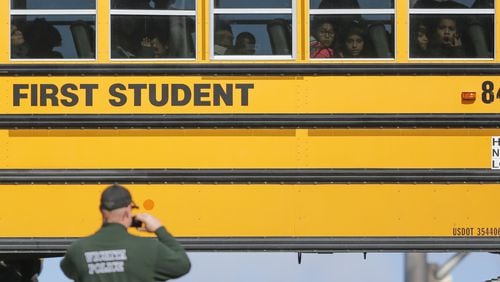School buses are the safest way for students to get to school. Just four children of the nearly 25 million who ride school buses each year die while on a bus. By contrast, nearly 500 school-aged children die each year in passenger cars during school travel hours, according to the National Highway Traffic Safety Administration (NHTSA).
School buses have a variety of safety features. Their color, lights and size make them easy to spot. Their height gives drivers a wide field of vision and keeps passengers above car-collision height. Tall, padded benches compartmentalize students like eggs in a carton, restricting their movement in the event of a collision. School buses must meet more federal safety standards than any other type of motor vehicle.
Nonetheless, the November crash of a school bus in Chattanooga, Tennessee that killed 6 children aged 6 to 10 has led many to ask if more should be done. Six states – New York, New Jersey, Florida, Louisiana, Texas and California – have gone a step further by mandating that school buses be equipped with seat belts.
Fulton County Schools this year became the first district in Georgia to purchase seat-belt-equipped buses. It purchased 90 buses, powered by propane, at a price of more than $91,000 each. The district intends to have more than 400 seat-belt-equipped buses within the next 5 years, according to its transportation director, Sam Ham.
Georgia has no state mandate, and the Georgia Department of Education has no official position on adding seat belts. Fulton could become a case study for the state, director of facility services and pupil transportation Pat Schofill said.
“I appreciate Fulton for stepping up,” said Schofill.
In 2011, NHTSA denied a petition to mandate seat belts in school buses nationwide. It noted that if 100 percent of students wore seat belts correctly, two lives could be saved each year. However, if the addition of seat belts reduced the capacity of school buses — forcing students to travel by car, bike or foot — 10 to 19 students could die each year. Furthermore, it would cost $7,346-$10,296 on average to equip a large school bus without losing capacity (the belts have to be able to adjust to children of all ages, heights and weights).
For the National Safety Council, that would be money well spent.
“You can’t put a price tag on someone’s life,” said NCS Spokesperson Maureen Vogel. “You’d never be able to tell a mother who’s lost a child, ‘Sorry, seat belts were too expensive.’ ”
The University Transportation Center for Alabama came to a different conclusion. In a 2010 seat belt study, researchers determined that money would have a larger impact if it were spent preventing casualties when loading and unloading buses. The study also observed that students only wore their seat belts 61.5 percent of the time on average.
However, the National Transportation Safety Board notes that seat belts have a significant impact when a school bus is hit from the side or rolls over. In investigations of accidents that occurred in New Jersey, Florida and California, NTSB determined that seat belts reduced injury and saved lives, especially three-point belts that go over the lap and shoulder.
The 90 buses Fulton purchased will be equipped with three-point belts and will make up 12 percent of its bus fleet. Schofill and GDOE are eager to study their impact.
“We’re about protecting 100 percent of students 100 percent of the time,” Schofill said.
About the Author






